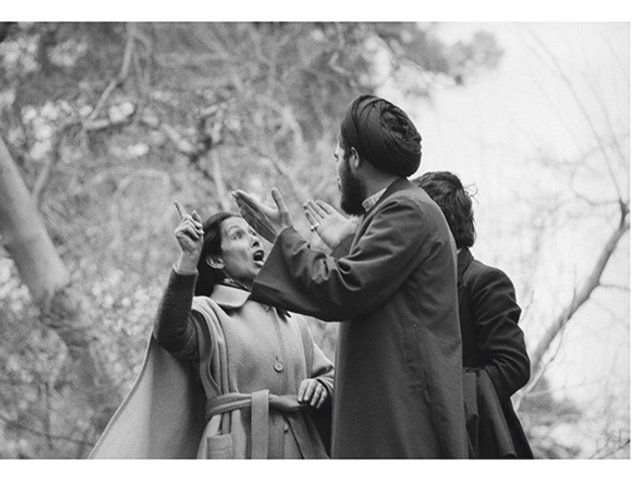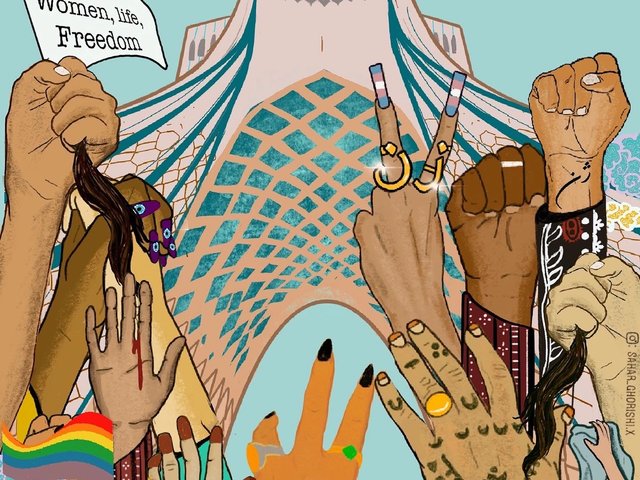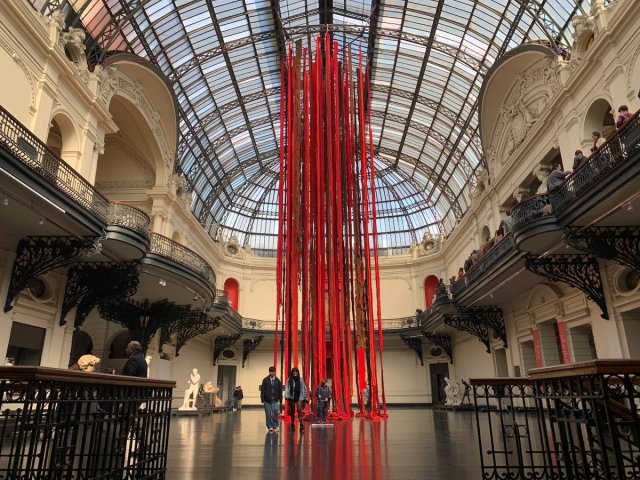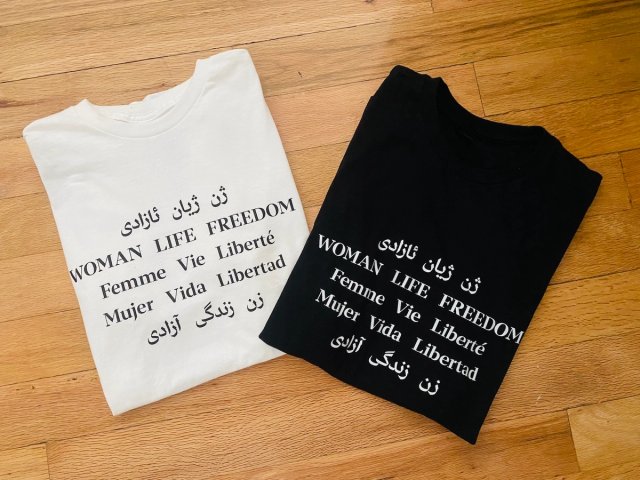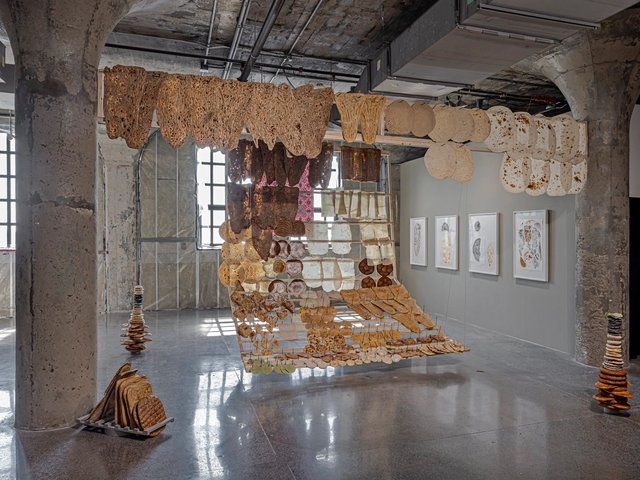The day that Iranian Canadian artist Leila Zelli installed her works at the Toronto Biennial of Art (until 1 December) was the two-year anniversary of the death of Mahsa Amini. “It was a coincidence,” the Montreal-based Zelli tells The Art Newspaper, “or was it?”
The work that Zelli calls “stamp art” is, like much of her recent oeuvre, inspired by the Women Life Freedom movement sparked in Iran and around the world by Amini’s death. As she created the temporary installation on the walls of 32 Lisgar St and Park—one of the main hubs of this year’s Toronto Biennial, whose title is Precarious Joys—she says, “It was moving for me, a mix of joy and frustration. But ultimately, I felt it was an act of resistance.”
Her installation at the biennial is part of an ongoing series called A Chant Can Cross the Ocean, featuring ink and acrylic prints of women removing their headscarves based on social media images and footage of protests, as well as birds as symbols freedom. Painted over two walls connected by a vertical joint, the latest iteration of the series is designed to be walked through, requiring the viewer’s participation. As one passes through the work, the crowds of protesters move with the viewer, who automatically enters the scene.
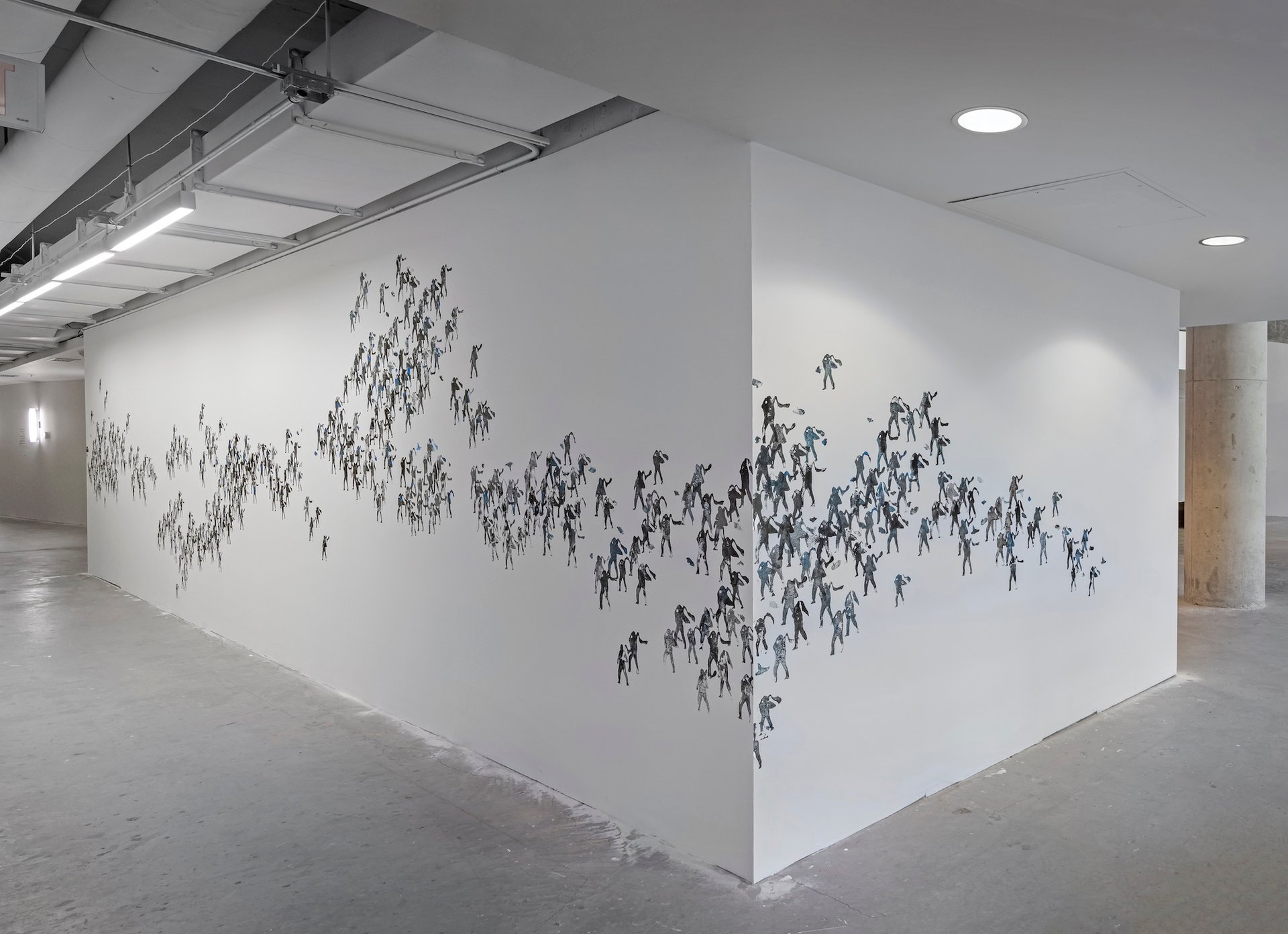
Leila Zelli, Un chant peut traverser l'océan (A chant can cross the ocean), 2023-present. On view at 32 Lisgar as part of the Toronto Biennial of Art, 2024. Co-presented with MOMENTA Biennale de l’image with the support of the Conseil des arts et des lettres du Québec. Photography: Toni Hafkenscheid.
Zelli, who says she “hasn’t stopped talking about women’s issues in Iran since 2022”, began the series as a Saturday afternoon ritual. “Every Saturday, I would participate in marches to support Iranian women,” she says. “I would return home and begin painting figures of women and birds in my studio.”
The work has a strong connection to the digital realm. The central motif is inspired by an image from a BBC broadcast in 2022 of a woman protester standing on top of a car and removing her hijab. But Zelli takes a painterly approach to depicting various frames of movement in a pictorial style.
“The image is important,” says Zelli, who trained as a painter and a photographer before moving into video art. “But I understood quickly that the fixed image doesn’t give me the freedom as an artist to express what I need to express. So, I moved into video.”
With video, she says, there is an amplification of meaning, plus an extra dimension. “There is sound, so you can understand what is not shown in the frame—what is happening outside of the image.”
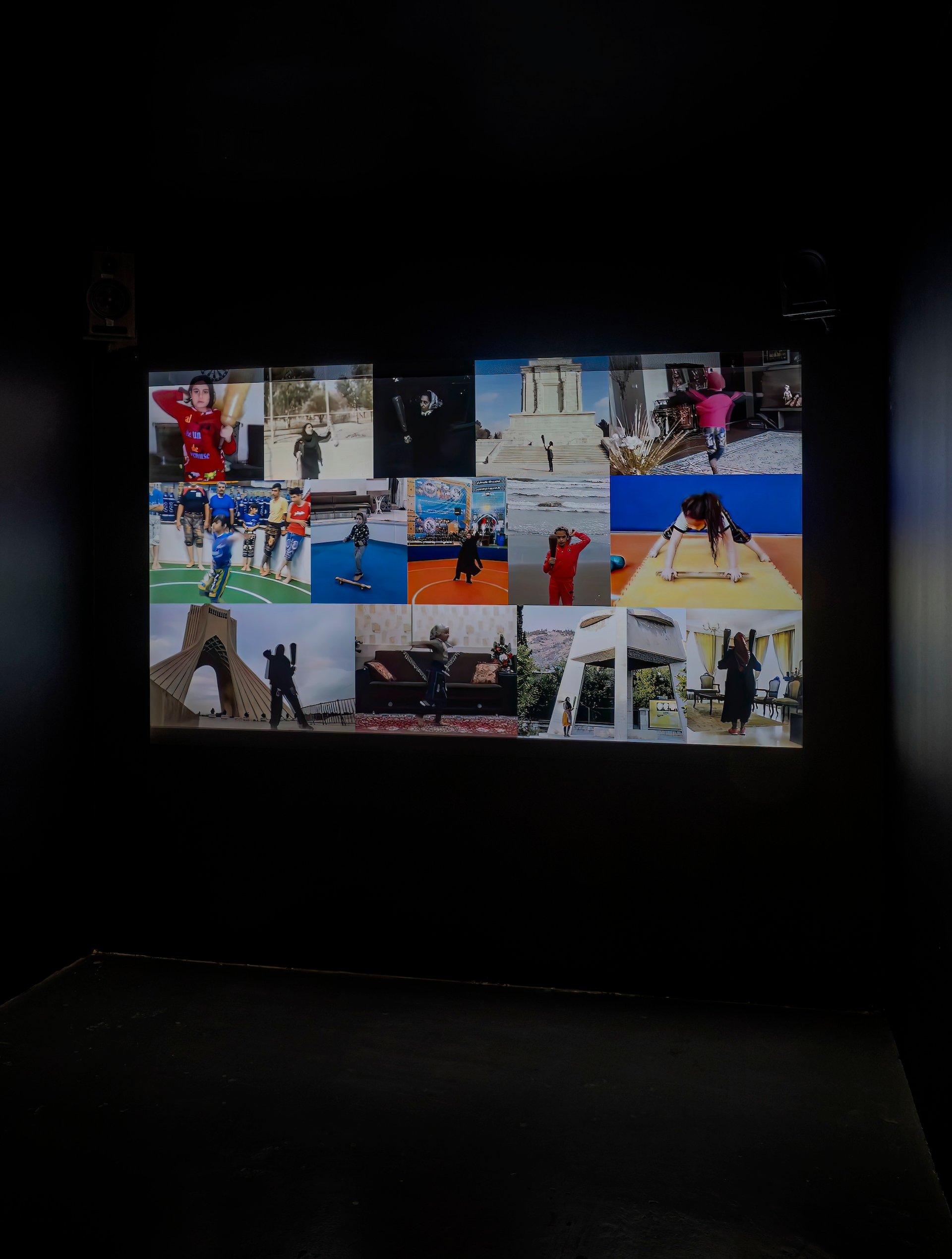
Leila Zelli, Pourquoi devrais-je m’arrêter? (Why should I stop?), 2020-21. On view at 32 Lisgar as part of the Toronto Biennial of Art, 2024. Co-presented with MOMENTA Biennale de l’image with the support of the Conseil des arts et des lettres du Québec. Photography: Toni Hafkenscheid.
Around the corner from the wall of stamp art, Zelli’s video work from 2020, Why Should I Stop,uses social media as an artistic material. Based on a poem by the Iranian poet Forugh Farrokhzad, which is printed in English on an adjacent wall and in farsi on a glass panel, the text speaks to both the video and stamp art works. It reads in part:
Why should I stop, why?
the birds have gone in search
of the blue direction.
the horizon is vertical, vertical
and movement fountain-like;
and at the limits of vision
shining planets spin.
The main video work in Zelli’s presentation, conceived specifically for the 2020-21 exhibition Quelque part, autrement (Somewhere, otherwise)—curated by Ariane De Blois, as part of the QUADrature project at the Galerie de l’UQÀM in Montreal—is a montage of Instagram videos honouring the strength and resilience of a group of Iranian women athletes. Following the Iranian government’s decision to ban women from practicing the ancient martial art Varzesh-e Bâstâni in public, many turned to social media to post images of themselves practicing the sport, which has traditionally been practiced by men only.
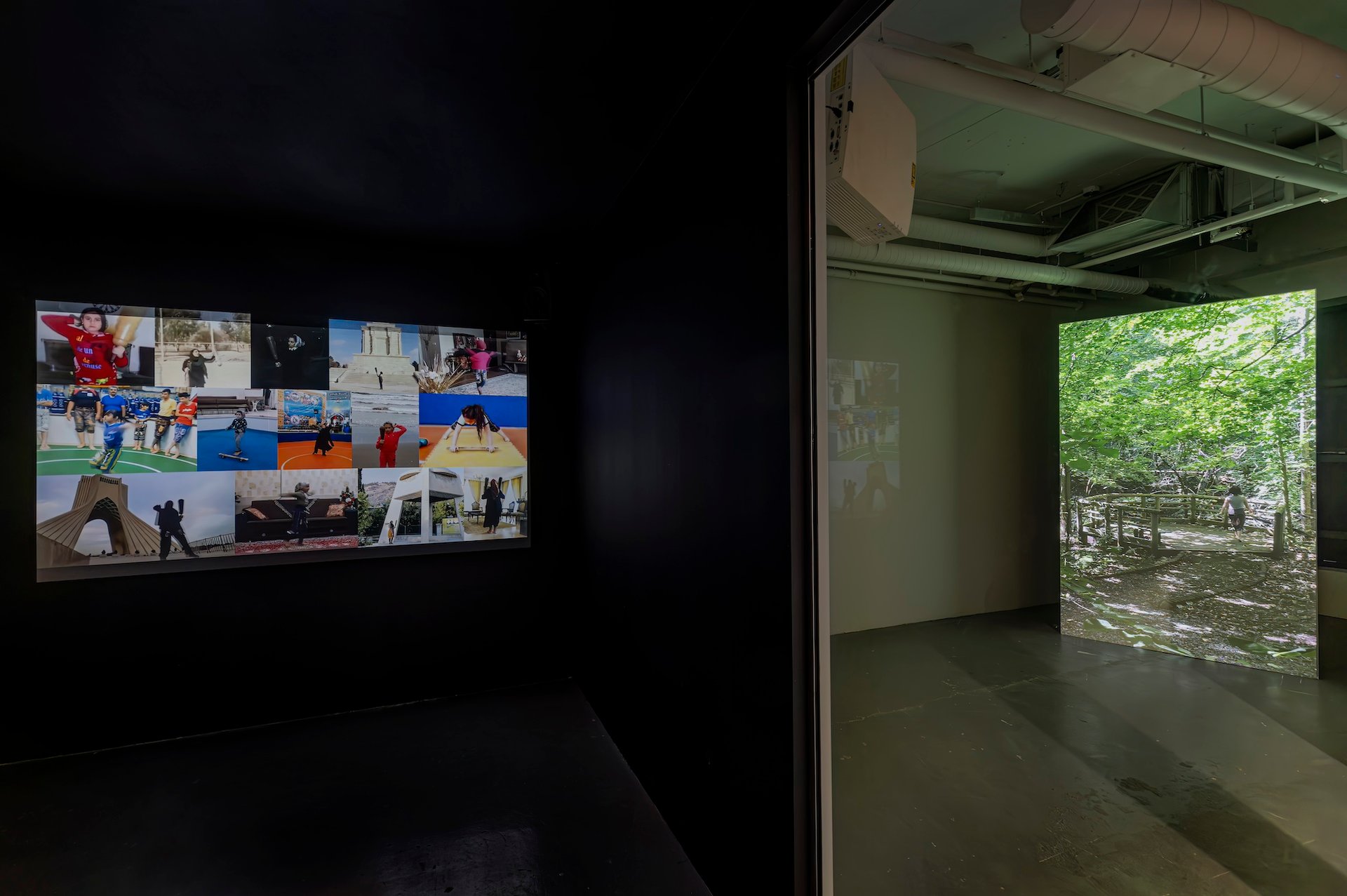
Leila Zelli, Pourquoi devrais-je m’arrêter? (Why should I stop?), 2020-21. On view at 32 Lisgar as part of the Toronto Biennial of Art, 2024. Co-presented with MOMENTA Biennale de l’image with the support of the Conseil des arts et des lettres du Québec. Photography: Toni Hafkenscheid.
Zelli has looped the images of women young and old practising the sport, which looks like a kind of Sufi-inspired tae kwon do and involves dervish-like spinning and handling of traditional weapons. The video emphasises their strength and resilience in the face of adversity. The musical piece accompanying the video is Maryam Akhondy's Zoorkhaneh, whose title refers to a traditional Iranian gymnasium. Taken together, the individual videos—filmed in isolation during the pandemic—form a kind of group Zoom call of female solidarity.
In a room next-door, a video of the artist in a wooded area near her home walking barefoot in circles around a traditional octagonal zoorkhaneh in a gesture of support for her sisters in Iran, offers a mesmeric, meditative loop in contrast with the often-frenzied movement of the Instagram videos. In turn, Zelli also uses Instagram to share documentation of her learning the rudiments of Varzesh-e Bâstâni, as taught by her father.

Leila Zelli, Pourquoi devrais-je m’arrêter? (Why should I stop?), 2020-21. On view at 32 Lisgar as part of the Toronto Biennial of Art, 2024. Co-presented with MOMENTA Biennale de l’image with the support of the Conseil des arts et des lettres du Québec. Photography: Toni Hafkenscheid.
Zelli left Iran when she was in her early twenties and has only returned once, a decade ago, but she says she feels a sense of responsibility to represent the reality of Iranian women in the West and to counteract their erasure in both Western media and Iranian society. “We don’t see anything about women and their resistance to oppression—we only see the war,” she says. “I want to show that it’s an ongoing struggle and movement in everyday life that is continuing in spite of everything.”
Zelli made an animated short with an Israeli artist in 2022 and says she has “criticised both regimes”. But she adds that the current war in the region makes it even harder for dissidents and protesters in Iran, who are labelled as complicit with Israel and the US. Still, like her stoic figure walking in a circle in her video—and like so many of her compatriots—Zelli continues what she calls “practising my freedom”.
- Leila Zelli, until 1 December, 32 Lisgar St and Park, Toronto, part of the 2024 Toronto Biennial of Art



